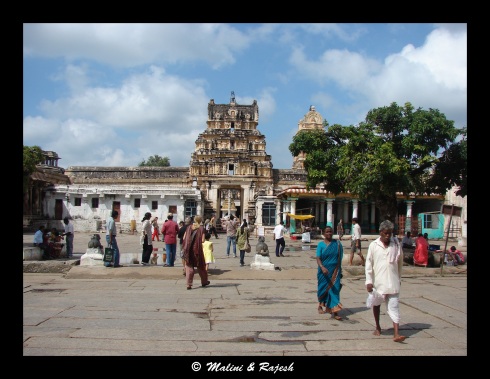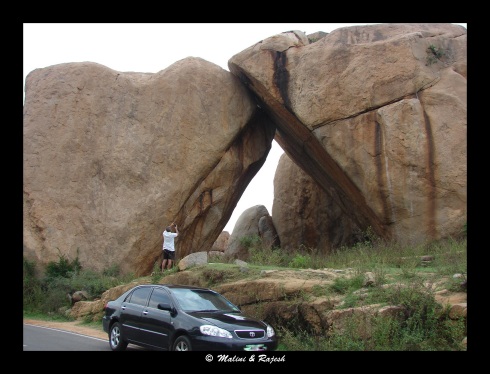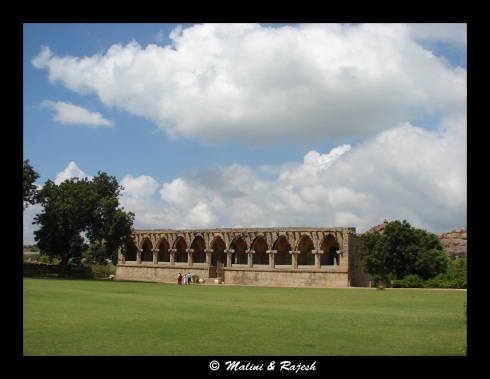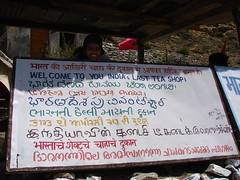The moped dragged us across the bumpy terrain of Hampi. Today was our last day in this surreal landscape. There was only one agenda in mind. Hire a moped and explore the ruins of Hampi. Follow the nose (of the moped) to the not much trodden paths and get lost somewhere among the boulders, broken palace basements, fallen temples and watch towers.
We had earlier rented a moped from Hampi bazaar and had paid Rs. 300, inclusive of the fuel. There are numerous shops in Hampi bazaar that rents out cycles, scooters and mopeds. They even let you to keep the vehicle overnight at your hotel. You just have to give them a xerox copy of any valid photo identity proof.
From Hampi bazaar we took the road to Kamalapura village. Right before the underground Shiva temple we saw a mud track and decided to follow it. After a few turns we reached a watch tower called the Mohammadan watch tower. The watch tower had steps leading up to a balcony which overlooked the mud track.
A few meters from the watch tower is the Danaik enclosure.
This was used as the military training area. Only the systematically partitioned basement of the enclosure remains.
Right next to the Danaik enclosure is a mosque and and another watch tower called the band tower.
On the other side of the Mohammadan watch tower is the noblemen’s quarters. This was where the aristocrats lived. Just like the Danaik enclosure, only the basement remains.
Right next to the quarters is a modern watch tower with steps, railings et al. We climbed the watch tower to get a better view of the whole area. The bird’s eye view was worth the climb.
Our next stop was Malyavanta Raghunatha temple. This temple is situated on top of Malyavanta hill which is on the way to Kampili village. The road was steep, winding and long.
I was obliged to dismount at a point and followed on foot.
The legend is that, after killing Bali, Rama and Lakshmana rested at this place before going in search of Sita.
The 3-storeyed eastern gopura of the temple leads into a large courtyard. There were a few neatly pruned trees and a few dogs enjoying their pre-noon siesta.
Other than a single devotee reading shlokas from Ramayana, we were the only people inside the complex. The temple has large pillared ornate mandapas on both sides.
From the western side of the temple you can step onto the Malyavanta hill and climb a bit further up. From the top of the hill you can get a view of the tough and rustic Hampi terrain.
There is a small shrine on top of the hill with a lot of shivalingas sculpted out from the rocks.
Our next stop, Pattabhirama temple, though as large as Vittala temple, is less frequented by tourists. It is is probably due to its location being a little away from the rest of Hampi and just beyond the Kamalapura village en route to Daroji Bear Sanctuary.
The security guard at the gate seemed a bit surprised to see us. He said only the most committed of visitors make it to Pattabhirama temple. Modestly patting ourselves, we entered into the temple complex through a side entrance.
The temple must have been a grand structure during its prime. The huge courtyard has various mandapas on all sides with the main sanctum at the center.
Other than the abundant simian population, both alive and sculpted, no other soul was in the premises.
Further down the road we came across a rectangular shaped structure with a dome called the Domed gate.
Within the Domed gate there is an image of Hanuman carved on the wall.
This gate had no similarities with the Bhima’s gate we had seen earlier. However, we did find some similarities with the Talarigatta gate we saw later.
In ancient Hampi, very few people would have had houses with private bath areas. People must have enjoyed going to public bath houses. We came across at least three public bath houses, not to mention the innumerable pushkarinis (water tanks) we saw.
The most magnificent of them all is the Queen’s bath pavilion, the bathing area for the queen and the mistresses.
The pavilion has a veranda that runs on all sides. In the middle is an open pond that can be accessed by steps. Projecting into the pond from the verandah are many balconies decorated with tiny windows. There are various aqueducts terminating inside the pond. The pavilion does not have a roof.
Around the building is a water channel that was probably designed to prevent intruders from walking into the pavilion when the women took bath! The Queen’s bath can be found right next to the road to Hampi bazaar.
Another public bath, the Octagonal bath, as the name suggests, is an octogonal bathing area.
The bath has an octagonal shaped platform with aqueducts at the middle and has a pillared veranda around it.
The area between the veranda and the platform must have been the bathing area. This is found on a mud path about a kilometer from the Queen’s bath.
The Octogonal water pavilion, found on the road to Hampi bazaar, could have been a magnificent water fountain in its prime.
Now practically in an abandoned stage with bushes and wild grass growing around, it looks more like a makeshift cooking place.
We had spent three days in Hampi and had not seen the sun rise or set. The sky was overcast on all days during dawn and dusk, not allowing us to capture the beautiful event. We climbed up the Hemakuta hill with whatever energy that remained to capture whatever remained of the sun through the overcast skies.
The Hemakuta hill is dotted with a lot of temples, the main being the Jain temples. The Jain temples look a bit different from the other temples. The main difference is in the stepped tower over the main shrine.
Hemakuta hill is an excellent vantage point. Other than the Virupaksha temple and the bazaar, a lot of other temples and ruins can be spotted from the top. Sun or no sun, a lot of tourists had come to enjoy the light cool breeze of the evening.
It was time for us to leave. Return journeys are the most toughest. What we did figure out, though, was that this journey was so worth it.



















































































































